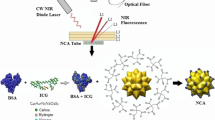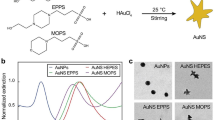Abstract
An innovative research has been conducted focused on demonstrating the ability of novel dual-emissive glutathione-stabilized gold nanoclusters (GSH-AuNCs) to perform bright near-infrared (NIR)–emitting contrast agents inside tissue-mimicking agarose-phantoms via two complementary confocal fluorescence imaging techniques. First, using a new and fast microwave-assisted approach, we synthesized photostable dual-emitting GSH-AuNCs with an average size of 3.2 ± 0.4 nm and NIR emission quantum yield of 9.9%. Steady-state fluorescence measurements coupled with fluorescence lifetime imaging microscopy (FLIM) assays performed on lyophilized GSH-AuNCs revealed that the obtained GSH-AuNCs exhibit PL emissions at 610 nm (red PL) and, respectively, 800 nm (NIR PL) in both solution and powder solid-state. Time-resolved fluorescence measurements showed that the two PL components are characterized by average lifetimes of 407 ns (red PL) and 1821 ns (NIR PL), respectively. Additionally, due to a partial overlap between the red PL and the absorption of the NIR PL, an energy transfer between the two coexisting emissive centers was discovered and confirmed via steady-state and time-resolved fluorescence measurements. Furthermore, the FLIM analysis performed on powder GSH-AuNCs under 640 nm, an excitation more suitable for bioimaging applications, revealed a homogeneous and photostable NIR PL signal from GSH-AuNCs. Finally, the ability of GSH-AuNCs to operate as reliable NIR-emitting contrast agents inside tissue-mimicking agarose-phantoms was demonstrated here for the first time via complementary FLIM and re-scan confocal fluorescence imaging techniques. In consequence, GSH-AuNCs show great promise for future in vivo imaging applications via confocal fluorescence microscopy.
Graphical abstract






Similar content being viewed by others
References
Widen JC, Tholen M, Yim JJ, Bogyo M (2020) Chapter Seven - Methods for analysis of near-infrared (NIR) quenched-fluorescent contrast agents in mouse models of cancer. In: Chenoweth DM (ed) Methods in enzymology. Academic Press, pp 141–166
Purich K, Dang JT, Poonja A et al (2020) Intraoperative fluorescence imaging with indocyanine green in hepatic resection for malignancy: a systematic review and meta-analysis of diagnostic test accuracy studies. Surg Endosc 34:2891–2903. https://doi.org/10.1007/s00464-020-07543-2
Zhang C, Jiang D, Huang B et al (2019) Methylene blue–based near-infrared fluorescence imaging for breast cancer visualization in resected human tissues. Technol Cancer Res Treat 18:1533033819894331. https://doi.org/10.1177/1533033819894331
Liu J, Duchesne PN, Yu M et al (2016) Luminescent gold nanoparticles with size-independent emission. Angew Chem Int Ed 55:8894–8898. https://doi.org/10.1002/anie.201602795
Zuber G, Weiss E, Chiper M (2019) Biocompatible gold nanoclusters: synthetic strategies and biomedical prospects. Nanotechnology 30:352001. https://doi.org/10.1088/1361-6528/ab2088
Xu H, Cheng D, Gao Y, Zeng XC (2018) Assessment of catalytic activities of gold nanoclusters with simple structure descriptors. ACS Catal 8:9702–9710. https://doi.org/10.1021/acscatal.8b02423
Hada A-M, Zetes M, Focsan M et al (2021) Novel paper-based sensing platform using photoluminescent gold nanoclusters for easy, sensitive and selective naked-eye detection of Cu2+. J Mol Struct 1244:130990. https://doi.org/10.1016/j.molstruc.2021.130990
Xu M-M, Jia T-T, Li B et al (2020) Tuning the properties of atomically precise gold nanoclusters for biolabeling and drug delivery. Chem Commun 56:8766–8769. https://doi.org/10.1039/D0CC03498C
Hada A-M, Craciun A-M, Focsan M et al (2021) Folic acid functionalized gold nanoclusters for enabling targeted fluorescence imaging of human ovarian cancer cells. Talanta 225:121960. https://doi.org/10.1016/j.talanta.2020.121960
van de Looij SM, Hebels ER, Viola M et al (2022) Gold nanoclusters: imaging, therapy, and theranostic roles in biomedical applications. Bioconjugate Chem 33:4–23. https://doi.org/10.1021/acs.bioconjchem.1c00475
Xie J, Zheng Y, Ying JY (2009) Protein-directed synthesis of highly fluorescent gold nanoclusters. J Am Chem Soc 131:888–889. https://doi.org/10.1021/ja806804u
Deng H-H, Zhang L-N, He S-B et al (2015) Methionine-directed fabrication of gold nanoclusters with yellow fluorescent emission for Cu2+ sensing. Biosens Bioelectron 65:397–403. https://doi.org/10.1016/j.bios.2014.10.071
Gao Y-C, Wang C, Zhang C-X et al (2021) Glutathione protected bimetallic gold-platinum nanoclusters with near-infrared emission for ratiometric determination of silver ions. Microchim Acta 188:50. https://doi.org/10.1007/s00604-021-04712-5
Feng J-J, Huang H, Zhou D-L et al (2013) Peptide-templated synthesis of wavelength-tunable fluorescent gold nanoparticles. J Mater Chem C 1:4720. https://doi.org/10.1039/c3tc30678j
Li H, Huang H, Feng J-J et al (2017) A polypeptide-mediated synthesis of green fluorescent gold nanoclusters for Fe3+ sensing and bioimaging. J Colloid Interface Sci 506:386–392. https://doi.org/10.1016/j.jcis.2017.07.062
Hembury M, Beztsinna N, Asadi H et al (2018) Luminescent gold nanocluster-decorated polymeric hybrid particles with assembly-induced emission. Biomacromol 19:2841–2848. https://doi.org/10.1021/acs.biomac.8b00414
Wen F, Dong Y, Feng L et al (2011) Horseradish peroxidase functionalized fluorescent gold nanoclusters for hydrogen peroxide sensing. Anal Chem 83:1193–1196. https://doi.org/10.1021/ac1031447
Li Y, Cao Y, Wei L et al (2020) The assembly of protein-templated gold nanoclusters for enhanced fluorescence emission and multifunctional applications. Acta Biomater 101:436–443. https://doi.org/10.1016/j.actbio.2019.10.035
Ash C, Dubec M, Donne K, Bashford T (2017) Effect of wavelength and beam width on penetration in light-tissue interaction using computational methods. Lasers Med Sci 32:1909–1918. https://doi.org/10.1007/s10103-017-2317-4
Pramanik G, Humpolickova J, Valenta J et al (2018) Gold nanoclusters with bright near-infrared photoluminescence. Nanoscale 10:3792–3798. https://doi.org/10.1039/C7NR06050E
Chuang C-H, Chen W-Y, Tseng W-B et al (2022) Microwave-mediated synthesis of near-infrared-emitting silver ion-modified gold nanoclusters for ratiometric sensing of hydrosulfide in environmental water and hydrogen sulfide in live cells. ACS Sustainable Chem Eng 10:2461–2472. https://doi.org/10.1021/acssuschemeng.1c07440
Zheng Y, Lai L, Liu W et al (2017) Recent advances in biomedical applications of fluorescent gold nanoclusters. Adv Coll Interface Sci 242:1–16. https://doi.org/10.1016/j.cis.2017.02.005
Pan Y, Li Y, Ma H, Li W (2019) Opposite changing dual-emission luminescence of gold nanoparticles by sulfhydryl to develop a pesticide biosensing strategy. Anal Methods 11:2327–2332. https://doi.org/10.1039/C9AY00445A
Yang Y, Lu L, Tian X et al (2019) Ratiometric fluorescence detection of mercuric ions by sole intrinsic dual-emitting gold nanoclusters. Sens Actuators, B Chem 278:82–87. https://doi.org/10.1016/j.snb.2018.09.072
Hada A-M, Craciun A-M, Astilean S (2021) Intrinsic photoluminescence of solid-state gold nanoclusters: towards fluorescence lifetime imaging of tissue-like phantoms under two-photon near-infrared excitation. Front Chem 9:761711. https://doi.org/10.3389/fchem.2021.761711
De Luca G, Breedijk R, Hoebe R et al (2017) Re-scan confocal microscopy (RCM) improves the resolution of confocal microscopy and increases the sensitivity. Methods Appl Fluoresc 5:015002. https://doi.org/10.1088/2050-6120/5/1/015002
Wang C, Fan W, Zhang Z et al (2019) Advanced nanotechnology leading the way to multimodal imaging-guided precision surgical therapy. Adv Mater 31:1904329. https://doi.org/10.1002/adma.201904329
Peng Y, Huang X, Wang F (2021) Near-infrared emitting gold–silver nanoclusters with large Stokes shifts for two-photon in vivo imaging. Chem Commun 57:13012–13015. https://doi.org/10.1039/D1CC04445A
Lakkakula JR, Divakaran D, Thakur M et al (2018) Cyclodextrin-stabilized gold nanoclusters for bioimaging and selective label-free intracellular sensing of Co2+ ions. Sens Actuators, B Chem 262:270–281. https://doi.org/10.1016/j.snb.2018.01.219
Taniguchi Y (2017) Autofluorescence imaging of tissue samples using super-high sensitivity fluorescence microscopy. Glob Imaging Insights 2:1–2 https://doi.org/10.15761/GII.1000135
Gibbs SL (2012) Near infrared fluorescence for image-guided surgery. Quant Imaging Med Surg 2:177–187. https://doi.org/10.3978/j.issn.2223-4292.2012.09.04
Borlan R, Focsan M, Maniu D, Astilean S (2021) Interventional NIR fluorescence imaging of cancer: review on next generation of dye-loaded protein-based nanoparticles for real-time feedback during cancer surgery. IJN 16:2147–2171. https://doi.org/10.2147/IJN.S295234
Cauzzo J, Nystad M, Holsæter AM et al (2020) Following the fate of dye-containing liposomes in vitro. IJMS 21:4847. https://doi.org/10.3390/ijms21144847
Joyce C, Fothergill SM, Xie F (2020) Recent advances in gold-based metal enhanced fluorescence platforms for diagnosis and imaging in the near-infrared. Materials Today Advances 7:100073. https://doi.org/10.1016/j.mtadv.2020.100073
Bera D, Qian L, Tseng T-K, Holloway PH (2010) Quantum dots and their multimodal applications: a review. Materials 3:2260–2345. https://doi.org/10.3390/ma3042260
Zheng P, Wu N (2017) Fluorescence and sensing applications of graphene oxide and graphene quantum dots: a review. Chem Asian J 12:2343–2353. https://doi.org/10.1002/asia.201700814
Liu J, Li R, Yang B (2020) Carbon dots: a new type of carbon-based nanomaterial with wide applications. ACS Cent Sci 6:2179–2195. https://doi.org/10.1021/acscentsci.0c01306
Hada A-M, Craciun A-M, Astilean S (2021) Gold nanoclusters performing as contrast agents for non-invasive imaging of tissue-like phantoms via two-photon excited fluorescence lifetime imaging. Analyst 146:7126–7130. https://doi.org/10.1039/D1AN01394G
Barnoy EA, Fixler D, Popovtzer R et al (2015) An ultra-sensitive dual-mode imaging system using metal-enhanced fluorescence in solid phantoms. Nano Res 8:3912–3921. https://doi.org/10.1007/s12274-015-0891-y
Pleijhuis R, Timmermans A, De Jong J et al (2014) Tissue-simulating phantoms for assessing potential near-infrared fluorescence imaging applications in breast cancer surgery. J Vis Exp 91:51776. https://doi.org/10.3791/51776
Polavarapu L, Manna M, Xu Q-H (2011) Biocompatible glutathione capped gold clusters as one- and two-photon excitation fluorescence contrast agents for live cells imaging. Nanoscale 3:429–434. https://doi.org/10.1039/C0NR00458H
Yang Z, Zhao Y, Hao Y et al (2021) Ultrasmall red fluorescent gold nanoclusters for highly biocompatible and long-time nerve imaging. Part Part Syst Charact 38:2100001. https://doi.org/10.1002/ppsc.202100001
Acknowledgements
This work was supported by CNCS-UEFISCDI, Project PN-III-P4-PCCF-2016-0142.
Author information
Authors and Affiliations
Corresponding authors
Ethics declarations
Conflict of interest
The authors declare no competing interests.
Additional information
Publisher's note
Springer Nature remains neutral with regard to jurisdictional claims in published maps and institutional affiliations.
Supplementary Information
Below is the link to the electronic supplementary material.
Rights and permissions
Springer Nature or its licensor holds exclusive rights to this article under a publishing agreement with the author(s) or other rightsholder(s); author self-archiving of the accepted manuscript version of this article is solely governed by the terms of such publishing agreement and applicable law.
About this article
Cite this article
Hada, AM., Craciun, AM., Focsan, M. et al. Glutathione-capped gold nanoclusters as near-infrared-emitting efficient contrast agents for confocal fluorescence imaging of tissue-mimicking phantoms. Microchim Acta 189, 337 (2022). https://doi.org/10.1007/s00604-022-05440-0
Received:
Accepted:
Published:
DOI: https://doi.org/10.1007/s00604-022-05440-0




